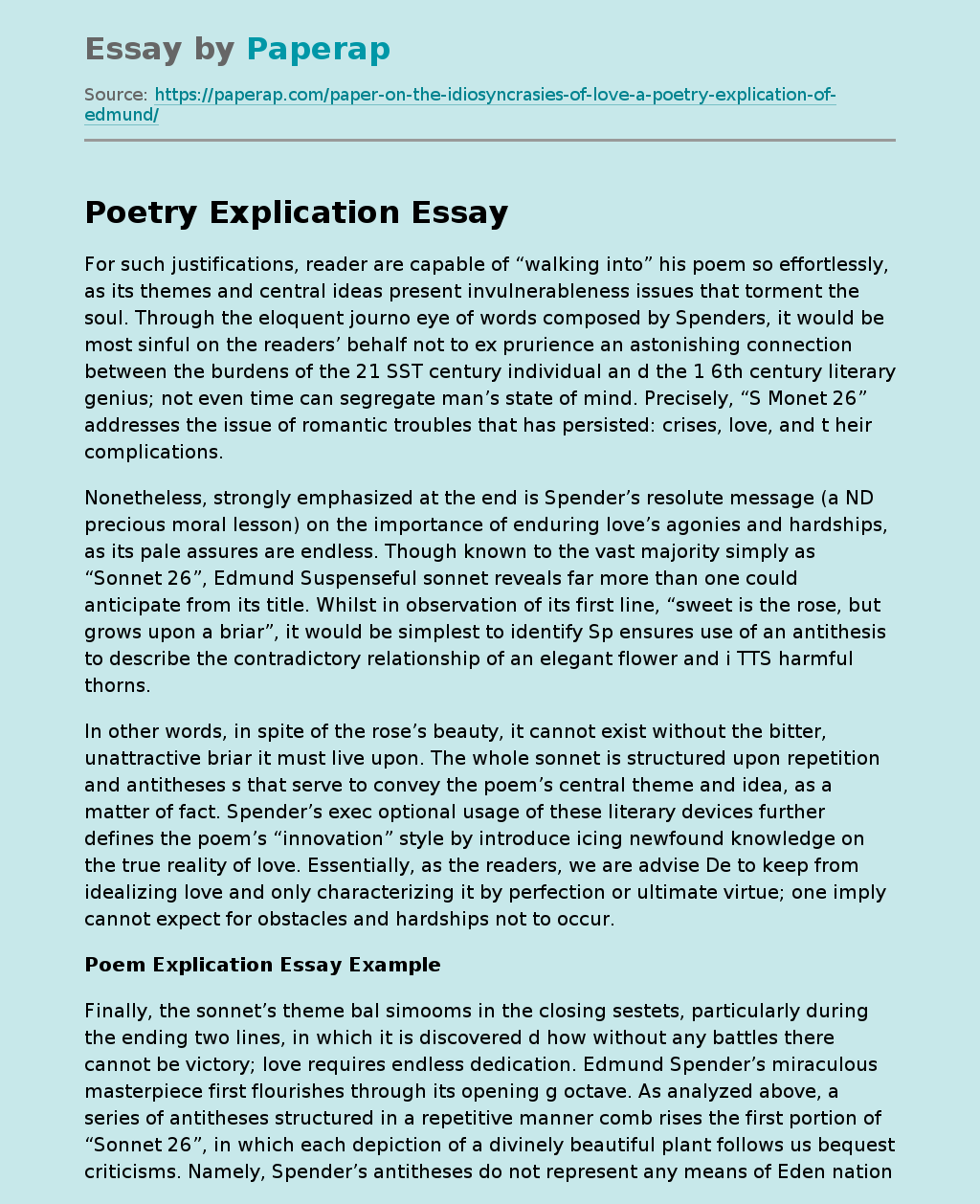Poetry Explication
For such justifications, reader are capable of “walking into” his poem so effortlessly, as its themes and central ideas present invulnerableness issues that torment the soul. Through the eloquent journo eye of words composed by Spenders, it would be most sinful on the readers’ behalf not to ex prurience an astonishing connection between the burdens of the 21 SST century individual an d the 1 6th century literary genius; not even time can segregate man’s state of mind. Precisely, “S Monet 26” addresses the issue of romantic troubles that has persisted: crises, love, and t heir complications.
Nonetheless, strongly emphasized at the end is Spender’s resolute message (a ND precious moral lesson) on the importance of enduring love’s agonies and hardships, as its pale assures are endless. Though known to the vast majority simply as “Sonnet 26”, Edmund Suspenseful sonnet reveals far more than one could anticipate from its title. Whilst in observation of its first line, “sweet is the rose, but grows upon a briar”, it would be simplest to identify Sp ensures use of an antithesis to describe the contradictory relationship of an elegant flower and i TTS harmful thorns.
In other words, in spite of the rose’s beauty, it cannot exist without the bitter, unattractive briar it must live upon. The whole sonnet is structured upon repetition and antitheses s that serve to convey the poem’s central theme and idea, as a matter of fact. Spender’s exec optional usage of these literary devices further defines the poem’s “innovation” style by introduce icing newfound knowledge on the true reality of love.
Essentially, as the readers, we are advise De to keep from idealizing love and only characterizing it by perfection or ultimate virtue; one imply cannot expect for obstacles and hardships not to occur.
Poem Explication Essay Example
Finally, the sonnet’s theme bal simooms in the closing sestets, particularly during the ending two lines, in which it is discovered d how without any battles there cannot be victory; love requires endless dedication. Edmund Spender’s miraculous masterpiece first flourishes through its opening g octave. As analyzed above, a series of antitheses structured in a repetitive manner comb rises the first portion of “Sonnet 26”, in which each depiction of a divinely beautiful plant follows us bequest criticisms. Namely, Spender’s antitheses do not represent any means of Eden nation, rather a means of realism.
By way of contrasts, Spenders presents an unmistakably nun versa truth the majority fails to recognize: perfection is futile as its existence is null. The occur cay of the aforementioned principle is not only valid in human mentality, but likewise in nature. That is to say, the rose may only preserve its charm if surrounded by thorns; the nut’s s wetness ceases to be attainable without its bitter shell. Though all justifiable, the claims above p assess far more Han simply literal meaning; they are symbols for the imperfections encounter De on a daily basis.
Though displayed in a considerably vague tone, Spender’s reasoning reveals a tenacious standing on the nature of perfection: he, for one, cannot be fooled. All ambiguities in “Sonnet 26” come resolved when the speaker’s genuine intent notions are unveiled in its concluding sestets: nature’s flaws unite with Edmund Spender’s own impaired romance. At the time during which it was written, Spenders had been pursuing the love of his life and Only woman Of any interest to him: Elizabeth Bayle. On behalf Of such ma terse, it is that the first Ana lines of the sestets that read, “so every sweet with sour is tempered SST ill.
That make it be coveted the more” are references to Spender’s personal acknowledgement s on the inevitable risks needed to be taken in order to love someone: some for the better, other s for the worse. Indeed, Spender’s own ordeals intensify his conveyed message about vivacity and euphoria being an inadequate measure of love; with every pleasure comes equal anguish. On e must be psychologically capable of enduring all agony and grief to await true love. In al verity, true love s at its very climax when its sufferers overcome its impediments; only then m ay the idealized image of emotion follow.
No value is there in hollow love that only exists in pop Tamil times; by the same token, casual affairs and insight stands only ignite with sensual pa Sino for ephemeral time periods. With his striking use of symbolism and figurative Ian gauge, Spender’s attitude morphs from subtle to forcefully resolute and assured when he claim s: “Why then should I account Of little pain, that endless pleasure shall unto me gain. ” Edmund Spenders expertise and insight on the human mentality rightfully cal jiffies his “Sonnet 26” as ‘those poems any man can walk into and make his own. By us mooning his age Doric readers into his little corner of the world, precisely, into the blooming core of his heart, Spenders invites his audience to analyze the meaning of love through poetic verse. His s Monet, rich in mean inning and connotations, offers a middling experience that interlaces it s central theme and message into a dignified work of art. With his deep wisdom and intellect, Spend ceros point of view was furthermore emphasized throughout his entire sonnet, defining his style and canny usage of literary devices.
Poetry Explication. (2019, Dec 05). Retrieved from https://paperap.com/paper-on-the-idiosyncrasies-of-love-a-poetry-explication-of-edmund/

